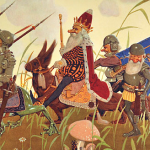 Movies and TV
Movies and TV  Movies and TV
Movies and TV  Politics
Politics The 10 Boldest Coup Attempts of the 21st Century
 Weird Stuff
Weird Stuff 10 Things That Would Have Killed You in the Old West
 Books
Books 10 Pen Names More Famous Than Their Authors
 Creepy
Creepy 10 Unnerving Legends from Around the World
 Movies and TV
Movies and TV 10 Amazing Lead Actor Ideas for Superhero Movies
 Our World
Our World 10 Crazy Facts about Cycads That Might Surprise You
 Technology
Technology 10 World-Changing Examples of Turning Dumb Technology into Smart Technology
 Pop Culture
Pop Culture Ten Celebrities Who Straight-Up Lied on Home Tours
 Animals
Animals 10 Remarkable Things We’ve Recently Learned about Animals
 Movies and TV
Movies and TV 10 Misdirections Directors Used to Manipulate Actors
 Politics
Politics The 10 Boldest Coup Attempts of the 21st Century
 Weird Stuff
Weird Stuff 10 Things That Would Have Killed You in the Old West
Who's Behind Listverse?

Jamie Frater
Head Editor
Jamie founded Listverse due to an insatiable desire to share fascinating, obscure, and bizarre facts. He has been a guest speaker on numerous national radio and television stations and is a five time published author.
More About Us Books
Books 10 Pen Names More Famous Than Their Authors
 Creepy
Creepy 10 Unnerving Legends from Around the World
 Movies and TV
Movies and TV 10 Amazing Lead Actor Ideas for Superhero Movies
 Our World
Our World 10 Crazy Facts about Cycads That Might Surprise You
 Technology
Technology 10 World-Changing Examples of Turning Dumb Technology into Smart Technology
 Pop Culture
Pop Culture Ten Celebrities Who Straight-Up Lied on Home Tours
 Animals
Animals 10 Remarkable Things We’ve Recently Learned about Animals
10 Child Rulers Who Died Miserable Deaths
Arguably one of the most famous rulers to have ascended to any throne in human history was Tutankhamun (1341–1323 BC). What sets the 11th Pharaoh of Egypt apart from many others is that he rose to power before his tenth birthday. After a nine-year rule over Egypt, Tutankhamun is suspected of having died of either malaria or another infection.
History tells of many other rulers who were crowned heads of their respective territories before reaching the age of majority. Like the young King Tut, these child rulers saw not only their reigns but also their lives come to a startlingly and tragic early end.
Related: 10 Royal Murders That Shocked Medieval Europe
10 Lungtok Gyatso, Ninth Dalai Lama (1805–1815)
The Ninth Dalai Lama, Lungtok Gyatso, was born in 1805 in a little village called Dan Chokhor in Kham, Tibet. Interestingly, a number of sources list Lungtok’s parents as Tenzin Choekyong and Dhondup Dolma, although many sources state that he was, in fact, an orphan. Lungtok was selected over another to be the reincarnation of the Eighth Dalai Lama, Jampel Gyatso.
Around the time of his reign, major regional power shifts took place. The Qing Dynasty struggled to retain power and influence in Tibet, and Tibetan leadership and aristocrats were at odds with Qing officials. The selection of the Dalai Lama was overseen by a Qing official, something that was contested by some Tibetan leaders. This was because the Qianlong Emperor mandated that selection be made from a golden urn supplied by the emperor, effectively giving control of the selection process to the Qing dynasty. The Tibetans managed to forego using the urn after the emperor announced his retirement. At the tonsure ceremony in 1808, the child was given the name Lobzang Tenpai Wangchuk Lungtok Gyatso. He took the throne at the end of that year.
In 1815, Gyatso, who was described as having sharp intellect, taking great interest in dharma, and memorizing lengthy prayers, allegedly fell ill with a cold. It is also reported that the Ninth Dalai Lama was actually assassinated due to the turmoil that ensued during the time of his reign. Notably, the three Dalai Lamas who followed all died young, raising suspicions that they were also murdered.[1]
9 Alexander IV of Macedon (323–309 BC)
Having to follow in very large footsteps, Alexander IV of Macedon was born in 323 BC, the son of Alexander the Great, after his father died in Babylon the same year. Alexander IV’s rise to the throne was neither immediate nor easy. The young king’s uncle, Arridaeus (who also went by Phillip), succeeded his brother as king but was soon found to be mentally incapable of acting as ruler. The regent to Arridaeus, Perdiccas, campaigned to put a hold on selecting a new successor in an effort to hold onto power and influence for himself. His efforts were met with a lot of resistance, however, and Alexander IV was born soon after.
Perdiccas was killed in 320 BC, and the then-guardian of the royal family, Antipater, was later killed in 319 BC. Antipater’s son, Cassander, plotted his way to the regency, forcing Roxane to flee Epirus with her young son and Polyperchon (a family guardian). There, the pair united with Olympias, the mother of Alexander the Great. Alexander IV’s status as successor and true king to the Macedonian throne was realized after Olympias retook Macedon and was named regent. In 316 BC, Cassander eventually managed to besiege and execute Olympias, and Cassander was accepted as regent.
In an effort to end the Third Diadoch War in 311 BC, a peace treaty that recognized Alexander IV’s rights and claim to the throne was established. Cassander, however, decided not to honor the treaty and imprisoned the young king and his mother in the citadel of Amphipolis. In 309 BC, the then thirteen-year-old king and his mother were assassinated by poisoning.[2]
8 Ptolemy XIII, Theos Philopator (62–47 BC)
In 51 BC, the father of twelve-year-old Ptolemy XIII and his older and more famous sister, Cleopatra VII, died. In the wake of his father’s death, Ptolemy was named senior ruler by the de facto regent, Pothinus, much to the dismay of co-ruler Cleopatra. Under the influence of Roman general Pompey the Great, Pothinus, and Theodotus, Ptolemy’s strong-willed older sister was eventually expelled from Egypt in 48 BC.
Not long after her expulsion, Cleopatra wielded an Arab army to help her siege the Egyptian city of Pelusium, sparking a civil war with her brother. Pompey, unfortunately, sealed his fate after losing to Julius Caesar at the Battle of Pharsalus in Greece. To win the favor of Caesar, Ptolemy set a trap for Pompey in Alexandria and ambushed him.
There in Alexandria, a peace treaty was attempted between the warring siblings but failed to produce a positive outcome. While the siblings were detained by Caesar, Pothinus pushed their youngest sister Arsinoe to the forefront and took Alexandria. Arisinoe, however, did not get along with the heads of the Egyptian forces and was successfully offered in exchange for Ptolemy. The young king was no match for Caesar and was defeated in battle. While running for his life, Ptolemy drowned, and Caesar asserted his dominance over Egypt.[3]
7 Emperor Antoku (1178–1185)
On December 22, 1178, Tokohito was born in Kyoto, Japan, to Emperor Takakura and his wife, Tokuko. The emperor’s son was named Crown Prince soon after his birth that same year. Although Tokohito took the throne a few years later in 1180 under the Taira clan at the tender age of two, it was his grandfather and warrior Taira Kiyomori who had sway and held control over the government. Tokohito took the name Antoku Tennō as the 81st emperor of Japan.
In 1183, the Taira clan was forced out of Kyoto City by men under the control of Minamoto Yoshinaka. Antoku and his clan eventually made their way to Yashima, where they would establish a temporary palace. Here, Minamoto and Antoku’s clans clashed in the Battle of Yashima. The shame of defeat caused Antoku to flee to the sea.
Two years later, the clans waged war against each other in the Battle of Dannoura, where the Taira clan would once again taste defeat and ruin at the hands of Minamoto’s naval fleet. Rather than die at the hands of the Minamoto fleet, many of the Taira clan’s commanders and fighters committed suicide by throwing themselves into the sea. Antoku’s grandmother followed suit, taking not only two of the three imperial regalia with her but the young emperor as well. Antoku and his grandmother plunged into the sea and drowned.[4]
6 Peter II of Russia (1715–1730)
The grandson of Peter I the Great, Pyotr Alekseyevich was born in 1715 in St. Petersburg, Russia. Sadly, Pyotr’s mother died only 10 days after giving birth to him. Peter I’s son from his second marriage, Tsarevitch Peter Petrovitch, had died, making way for his grandson, Pyotr, to eventually become the Emperor of Russia. This was only made possible after a close adviser to Peter I and Catherine I, A.D. Menshikov, influenced Catherine to include young Pyotr in her will in 1727. Catherine I died, and Pyotr, who took the name Peter II, was declared emperor.
Menshikov wasted no time manipulating the young ruler once he had moved him into his house within the first few months of his reign. Peter II, who was promised to marry Menshikov’s daughter, was not pressed under the adviser’s thumb for much longer as he fell ill and was eventually exiled to Siberia by the aristocratic Dolgoruky family. Peter was instead betrothed to Yekaterina Alekseyevna Dolgorukaya in 1729. With a stroke of horrible luck, however, Peter II died of smallpox on the day set for the wedding. He was only fourteen years old.[5]
5 Edward VI (1537–1553)
Sixteenth-century England fell prey to the rule of one of the most infamous and ruthless monarchs to have lived, Henry VIII, for more than 30 years. After his death in 1547, he was succeeded by his son, Edward VI. Because the king was a mere nine years of age, a council of nobles had the task of managing the affairs of the kingdom. This group included the king’s uncle, Edward Seymour—until he was overthrown by the Earl of Northumberland, John Dudley.
The political and religious climate at this time was one of Protestant reformation and economic instability. Furthermore, the king’s place as ruler was on rocky ground as the ambitious Northumberland moved to secure the future of his family by hastily marrying his son to Henry VIII’s great-niece, Lady Jane Grey, who was widely accepted by the people as heir to the throne. During this time, Edward VI was discovered to be suffering from tuberculosis. Edward, the last Tudor baby to be born, never married and died at the age of fifteen.[6]
4 Emperor Zhao Bing (1272–1279)
Emperor Bing of Song, born Zhao Bing in 1272 to a concubine of Emperor Duzong, was destined to become the last emperor of China’s Song dynasty. Before holding the title of emperor, he was given the title “Prince of Xin” in 1274, after which it was changed to “Prince of Guang.”
Bent on conquest and glory, Mongol forces led by general Bayan took the Song capital of Lin’an and, with it, the then-Emperor Gong. Gong’s brothers, four-year-old Zhao Bing and Zhao Shi, fled to Jinhua with the help of their officials. There, Zhao Shi was named Grand Marshal, and his brother Zhao Bing, Vice Grand Marshal. By 1276, a seven-year-old Zhao Shi became the new Song emperor, Emperor Duanzong.
General Bayan was determined to rid China of any remaining Song dynasty members and led an attack on Southern China. The Song army hit a major roadblock in this fight as the young Emperor Duanzong would not live past 1278 due to illness. With low morale, the number of Song soldiers started to diminish. Lu Xiufu, one of the officials who previously helped the brothers escape peril, would once again step in and flee with Zhao Bing to Guangzhou, where he would eventually be named emperor.
Facing imminent defeat in 1279 at the hands of the Mongol naval forces, Lu Xiufu took the seven-year-old Emperor Zhao Bing to a cliff and plunged into the depths of the ocean together. With this act, the Song dynasty had come to a tragic end.[7]
3 Alexios II Komnenos, Byzantine Emperor (1169–1183)
The life of Alexios II was a turbulent one. The future emperor was born in Constantinople (now Istanbul, Turkey) in 1169. Eleven years later, his father, Manuel I, died, leaving behind his son and Alexios II’s mother, Maria. Because it was determined that the new emperor, Alexios II, was too young to rule, his mother took up the regency alongside Alexios II’s cousin, who also shared the name Alexios.
Turmoil would soon follow as friends of Alexios II attempted a coup intended to secure the young emperor’s place on the throne. In response to the coup attempt, however, rioting took place in Constantinople, and the failed attempt was capitalized upon by Emperor Manuel’s first cousin, Andronikos Komnenos. Andronikos seized control of the Constantinople government, and a slaughter of thousands of Roman Catholic inhabitants ensued.
In a bid to eventually seize power for himself, Andronikos isolated Alexios II by killing his mother, older sister, and his cousin Alexios. What’s worse is that the young emperor was apparently made to forcibly sign off on the death warrants himself. By 1183, Andronikos made himself co-emperor. In October of that year, the plot to gain absolute power came to a head when Andronikos gave the order to assassinate Alexios II. He was strangled to death with a bowstring.[8]
2 Edward V of England (1470–1483)
Edward was born at Westminster Abbey in 1470, a time when the War of the Roses raged on. In 1471, at a mere one year old, Edward was deemed Prince of Wales by his father, King Edward IV, who was living in Holland in exile at the time. The young prince lived a very strict and structured upbringing as dictated by his father. Receiving an education, exposure to religion, and having positive influences around him were the order of the day. A betrothal to the Duke of Brittany’s young daughter Anne was also arranged as a means of strengthening political and military ties. Sadly, this marriage union would never come to fruition.
At age twelve, Edward learned of the death of his father in April of 1483. The fallen king’s son became King Edward V soon after. The former king’s brother, Richard, Duke of Gloucester, was appointed Edward’s protector. Conflict soon arose between the protectorate and the royal council, which was mainly comprised of the family of Edward’s mother, the Woodvilles, who wanted the young king to take the throne right away. In reality, the Woodvilles wanted a regency for their own benefit instead of Edward V under the protection of the Duke of Gloucester.
The duke eventually arrested the Woodville leadership and took custody of Edward V and his younger brother, who were taken to the Tower of London. Gloucester later claimed that the marriage of the king’s father was not valid, and the king and his brother were illegitimate. On June 26, parliament declared Gloucester as King Richard III. The young monarch was ruler for a mere two months and seventeen days.
The disappearance of the young king and his brother is shrouded in a cloud of mystery. It is believed that they were murdered at the Tower of London after being held in heavily guarded captivity. Sir Thomas More later wrote that the young king and his brother were smothered to death. In 1674, two remains believed to be that of the boys were discovered by King Charles II and laid to rest at Westminster Abbey.[9]
1 John I of France (1316)

The only son of King Louis X and Clémence of Hungary was born in Paris on November 15, 1316. Because the child king was born after the death of King Louis X, he was known as “John the Posthumous” (Jean le Posthume).
Tragically, John I only lived to see five days on Earth and was dead on November 20. The infant was buried in Saint-Denis Basilica. It is speculated that John I was killed by his uncle and future king Philippe V as a means of gaining power and control of the throne for himself. Other rumors state that Philippe replaced the still-living child with a dead infant. This claim has never been proven. Decades later, a man claimed to be the supposed king John I but was swiftly detained, imprisoned in Naples, and died there.[10]








